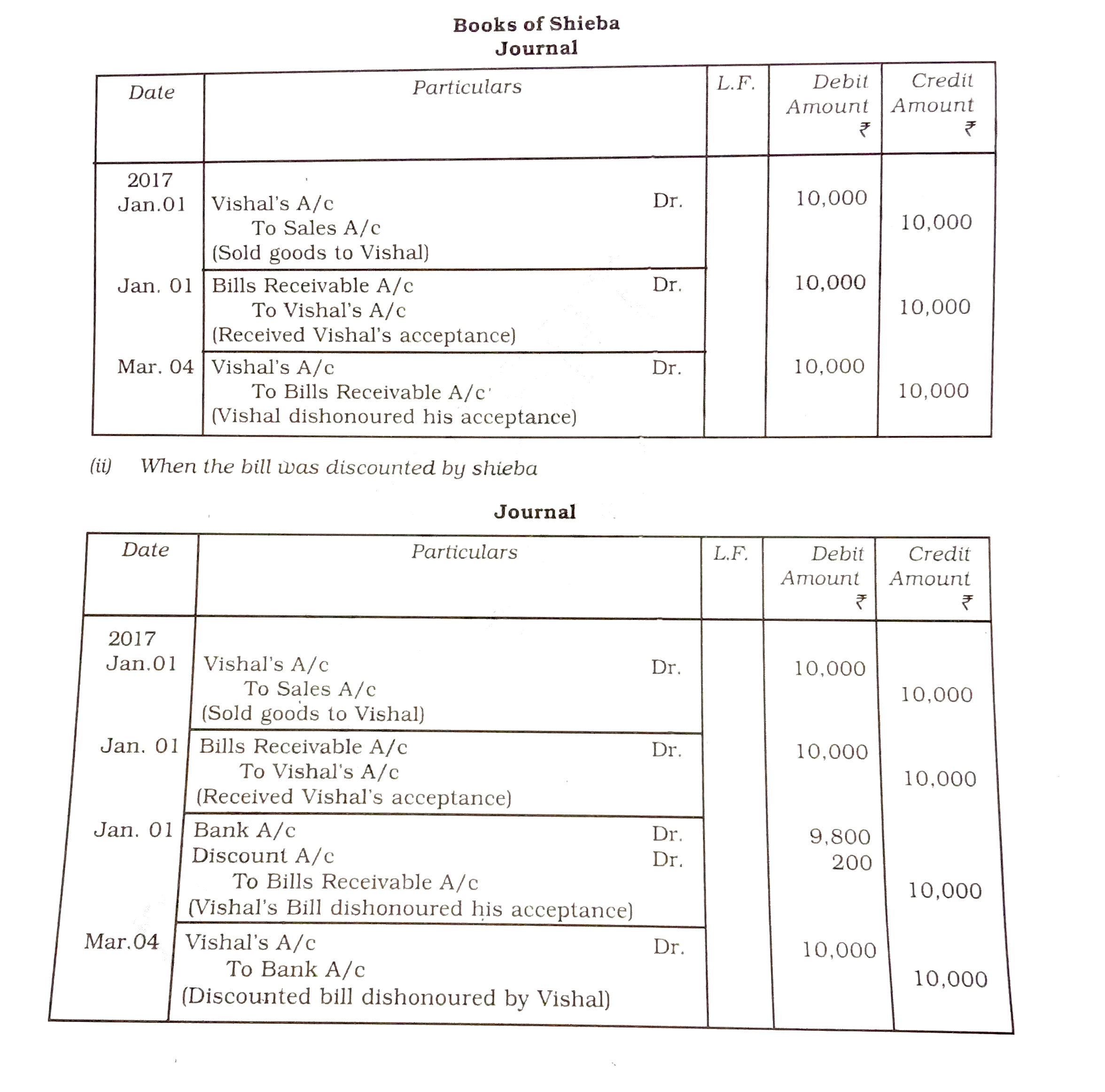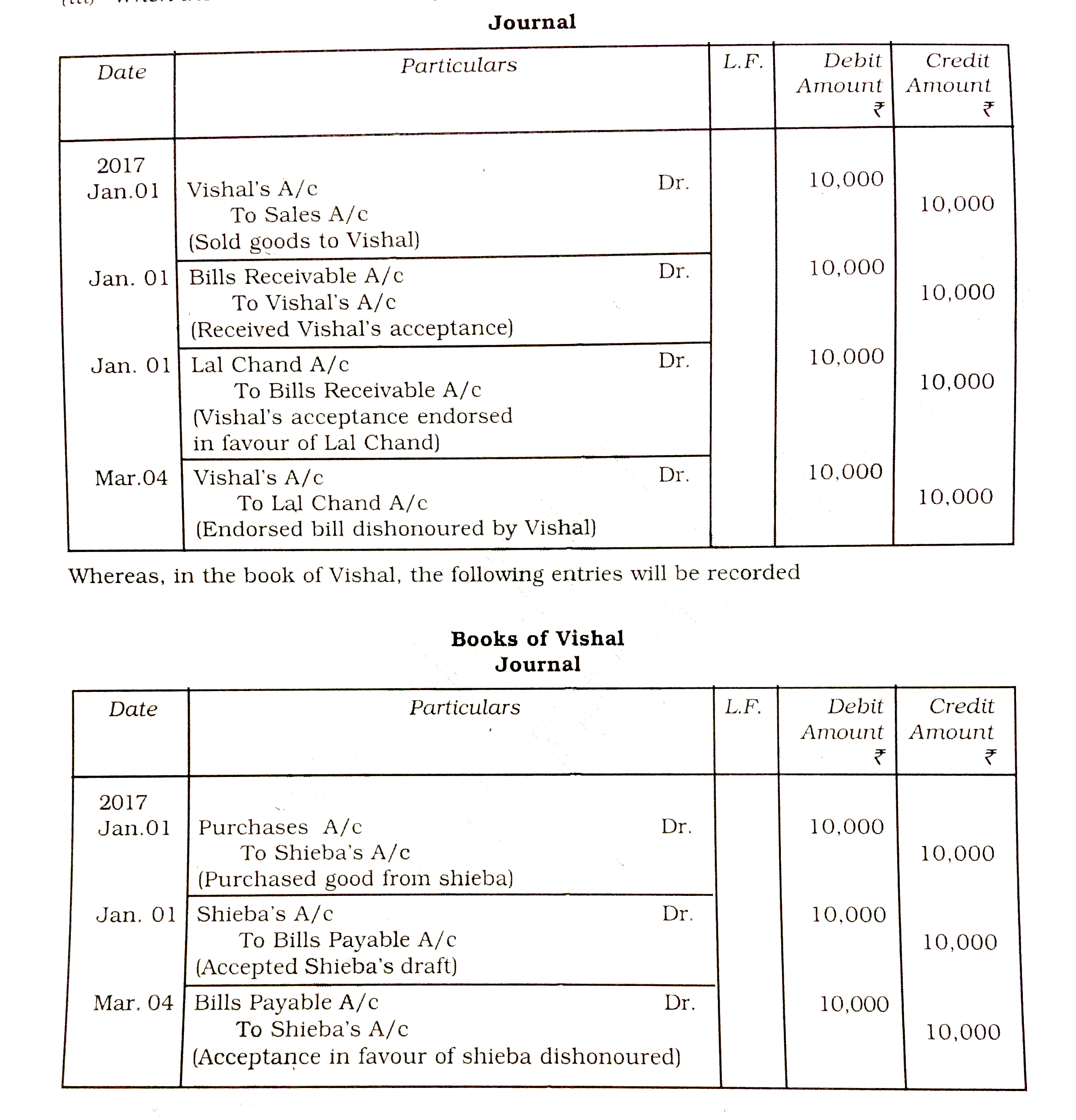On Jan 01,2017 Shieba sold goods to Vishal for Rs 10,000 and drew upon him a bill of exchange for 2 months. Vishal accepted the bill and returned it to Shieba. On the date of maturity the bill was dishonoured by Vishal. Record the necessary entries in all the cases listed below in the books of Shieba and Vishal:
(i) When the bill kept by Shieba till its maturity,
(ii) When the bill is discounted by Shieba for Rs 200,
(iii) When the bill is endorsed to Lal Chand by Shieba.
Topper's Solved these Questions
- BILL OF EXCHANGE Book:NCERTChapter:BILL OF EXCHANGE Exercise:Test Your Understanding-I
Explore 10 Videos
- BILL OF EXCHANGE Book:NCERTChapter:BILL OF EXCHANGE Exercise:Test Your Understanding-II
Explore 8 Videos
- BANK RECONCILIATION STATEMENTBook:NCERTChapter:BANK RECONCILIATION STATEMENTExercise:LONG ANSWER
Explore 3 Videos
- CASH FLOW STATEMENT Book:NCERTChapter:CASH FLOW STATEMENT Exercise:Numerical Questions
Explore 12 Videos
Similar Questions
Maturity Of Bills
View SolutionDarshan sold goods for Rs 40,000 to Varun on 8.1.2016 and drew upon him a bill of exchange payable after two months. Varun accepted the bill and returned the same to Darshan. On the due date the bill was met by Varun. Record the necessary Journal entries in the books of Darshan and Varun in the following circumstances.
• When the bill was retained by Darshan till the date of its maturity.
• When Darshan immediately discounted the bill @ 6% p.a. with his bank.
• When the bill was endorsed immediately by Darshan in favour of his creditor Suresh.
• When three days before its maturity, the bill was sent by Darshan to his bank for collection.
View Solution
Knowledge Check
A bill of exchange is:
AA conditional promise to payBAn unconditional order to payCAn unconditional promise to payDA conditional order to payA bill of exchange is:
AA conditional promise to payBAn unconditional order to payCAn unconditional promise to payDA conditional order to payA bill of exchange is:
AA conditional promise to payBAn unconditional order to payCAn unconditional promise to payDA conditional order to pay
On 1st January 2019, A sold to B for ₹ 10, 000 and drew upon him a billl at 3 months for the amount. B accepted the bill and returned it to A. on 4th March, 2019, B retired the bill under rebate of 6 % p.a.
Record these transactions in the Journal of A and B.
View SolutionBill of Exchange is drawn by the drawer and accepted by the drawee.
View SolutionViaml purchased goods Rs 25,000 from Kamal on Jan 15, 2016 and accepted a bill of exchange drawn upon him by Kamal payable after two months. On the date of the maturity the bill was duly presented for payment. Vimal dishonoured the bill. record the necessary journal entries in the books of Kamal and Vimal when.
• The bill was retained by Kamal till the date of its maturity.
• The bill was immediately discounted by Kamal with his bank @ 6% p.a.
• The bill was endorsed by Kamal in favour of his creditor Sharad.
• Five days before its maturity the bill was sent by Kamal to his bank for collection
View SolutionOn 1st January , 2019 A drew a bill on B for ₹ 10,000 payable after 3 months . B accepted the bill and returened it ot A. After 10 days. A endorsed the bill creditor C. On the due date, the bill was dishonoured and C paid ₹ 50 as noting charges.
Record the transactions in the books of A,B and C.
View SolutionAmit sold goods for Rs 20,000 to Sumit on credit on Jan 01,2017. Amit drew a bill of exchange upon Sumit for the same amount for three months. Sumit accepted the bill and returned it to Amit. Sumit met this acceptance on maturity. Record the necessary journal entries under the following circumstances:
(i) Amit retained the bill till the date of its maturity and collected directly
(ii) Amit discounted the bill @ 12% p.a from his bank
(iii) Amit endrsed the bill to this creditor Ankit
(v) Amit retained the bill and on March 31,2017 Amit sent the bill for collection to its bank. On April 05,2017 bank advice was received.
View Solution


